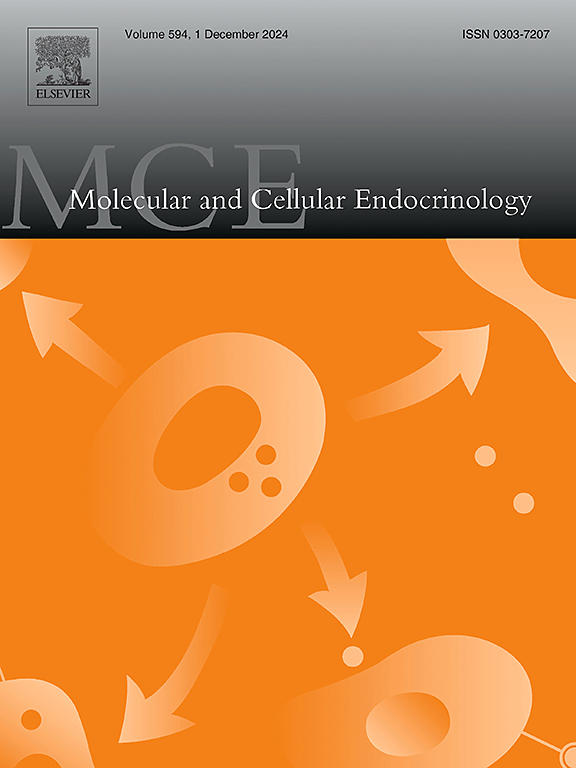高浓度黄体酮会抑制 MA-10 Leydig 细胞中与类固醇代谢有关的基因的表达。
IF 3.8
3区 医学
Q2 CELL BIOLOGY
引用次数: 0
摘要
莱德细胞是男性体内主要的睾酮生成细胞。在雄激素合成过程中,胆固醇通过 STAR 蛋白进入线粒体,并被 CYP11A1 酶转化为孕烯醇酮。然后,这种类固醇从线粒体输出,在内质网中被 HSD3B1 酶代谢为孕酮。在这项研究中,我们使用 3'Tag-RNA-Seq 技术鉴定了 MA-10 Leydig 细胞中受孕酮调控的基因。我们的研究结果表明,高浓度孕酮(30 μM)参与了一个负反馈回路,抑制了 cAMP/PKA 依赖性激活 Star 和 Cyp11a1 的表达,并参与了 cAMP/PKA 依赖性下调与类固醇激素代谢相关的基因。与 MAPK 信号通路的激活、内质网应激和细胞凋亡有关,在 MA-10 Leydig 细胞中,大多数编码 bZIP 转录因子的基因都会被孕酮上调。然而,在 MA-10 Leydig 细胞中,只有 DDIT3 蛋白水平在黄体酮作用下升高。与正常的 Leydig 细胞一样,MA-10 细胞表达黄体酮的经典核受体的能力很弱,这表明黄体酮对基因的调控是由黄体酮的非经典膜受体之一介导的。此外,siRNA 介导的 PAQR9 敲除反而会抑制 cAMP/PKA 通路激活时孕酮合成的增加。总之,这项研究表明,莱地格细胞产生的孕酮在激活 cAMP/PKA 通路时通过负反馈的自分泌作用参与类固醇生成的调节。本文章由计算机程序翻译,如有差异,请以英文原文为准。
High concentrations of progesterone inhibit the expression of genes related to steroid metabolism in MA-10 Leydig cells
Leydig cells are the main testosterone-producing cells in males. During androgen synthesis, cholesterol enters the mitochondria via the STAR protein and is converted into pregnenolone by the CYP11A1 enzyme. This steroid is then exported from the mitochondria to be metabolized to progesterone by the HSD3B1 enzyme in the endoplasmic reticulum. In this study, we used 3′Tag-RNA-Seq to identify progesterone-regulated genes in MA-10 Leydig cells. Our results indicate that high concentrations of progesterone (30 μM) are involved in a negative feedback loop that inhibits cAMP/PKA-dependent activation of Star and Cyp11a1 expression and participate in cAMP/PKA-dependent down-regulation of genes related to the metabolism of steroid hormones. Linked to activation of the MAPK signaling pathway, endoplasmic reticulum stress and apoptosis, most of the genes encoding bZIP transcription factors are upregulated by progesterone in MA-10 Leydig cells. However, only DDIT3 protein levels are increased in response to progesterone in MA-10 Leydig cells. Like normal Leydig cells, MA-10 cells very weakly express the classical nuclear receptor for progesterone, suggesting that gene regulation by progesterone is rather mediated by one of the non-classical membrane receptors for progesterone However, current findings suggest that the inhibitory effect of progesterone on STAR protein increase in response to forskolin is not dependent on PGRMC1/2 or PAQR9. Furthermore, the increase in progesterone synthesis in response to activation of the cAMP/PKA pathway is rather inhibited by siRNA-mediated knockdown of PAQR9. Overall, this study shows that progesterone produced by Leydig cells participates in the regulation of steroidogenesis through autocrine action involving negative feedback upon activation of the cAMP/PKA pathway.
求助全文
通过发布文献求助,成功后即可免费获取论文全文。
去求助
来源期刊

Molecular and Cellular Endocrinology
医学-内分泌学与代谢
CiteScore
9.00
自引率
2.40%
发文量
174
审稿时长
42 days
期刊介绍:
Molecular and Cellular Endocrinology was established in 1974 to meet the demand for integrated publication on all aspects related to the genetic and biochemical effects, synthesis and secretions of extracellular signals (hormones, neurotransmitters, etc.) and to the understanding of cellular regulatory mechanisms involved in hormonal control.
 求助内容:
求助内容: 应助结果提醒方式:
应助结果提醒方式:


